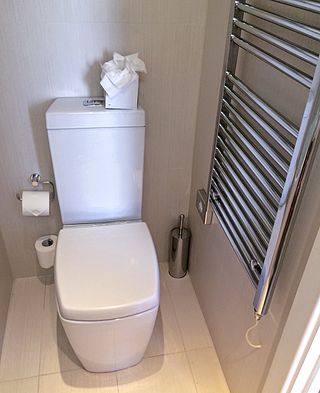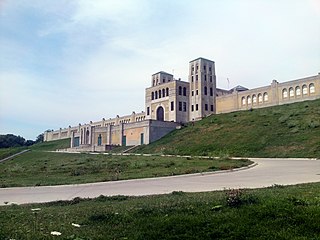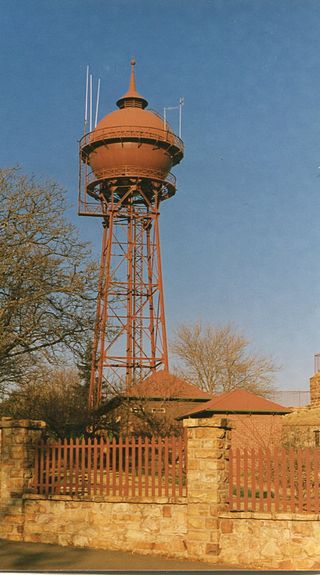
A water tower is an elevated structure supporting a water tank constructed at a height sufficient to pressurize a distribution system for potable water, and to provide emergency storage for fire protection. Water towers often operate in conjunction with underground or surface service reservoirs, which store treated water close to where it will be used. Other types of water towers may only store raw (non-potable) water for fire protection or industrial purposes, and may not necessarily be connected to a public water supply.

A fire engine, firetruck, or fire ambulance is a vehicle, usually a specially-designed or modified truck, that functions as a firefighting apparatus. The primary purposes of a fire engine include transporting firefighters and water to an incident as well as carrying equipment for firefighting operations in a fire drill. Some fire engines have specialized functions, such as wildfire suppression and aircraft rescue and firefighting, and may also carry equipment for technical rescue.

A flush toilet is a toilet that disposes of human waste by using the force of water to flush it through a drainpipe to another location for treatment, either nearby or at a communal facility, thus maintaining a separation between humans and their waste. Flush toilets can be designed for sitting or squatting, in the case of squat toilets. Most modern sewage treatment systems are also designed to process specially designed toilet paper. The opposite of a flush toilet is a dry toilet, which uses no water for flushing.

A fire hydrant, fireplug, or firecock (archaic) is a connection point by which firefighters can tap into a water supply. It is a component of active fire protection. Underground fire hydrants have been used in Europe and Asia since at least the 18th century. Above-ground pillar-type hydrants are a 19th-century invention.

The Massachusetts Water Resources Authority (MWRA) is a public authority in the Commonwealth of Massachusetts that provides wholesale drinking water and sewage services to 3.1 million people in sixty-one municipalities and more than 5,500 large industrial users in the eastern and central parts of the state, primarily in the Boston area.

A fireboat or fire-float is a specialized watercraft with pumps and nozzles designed for fighting shoreline and shipboard fires. The first fireboats, dating to the late 18th century, were tugboats, retrofitted with firefighting equipment. Older designs derived from tugboats and modern fireboats more closely resembling seafaring ships can both be found in service today. Some departments would give their multi-purpose craft the title of "fireboat" also.

A draft is the use of suction to move a liquid such as water from a vessel or body of water below the intake of a suction pump. A rural fire department or farmer might draft water from a pond as the first step in moving the water elsewhere. A suction pump creates a partial vacuum and the atmospheric pressure on the water's surface forces the water into the pump, usually via a rigid pipe or a semi-rigid hard suction hose.
This is a glossary of firefighting equipment.

Toronto Water is the municipal division of the City of Toronto under Infrastructure and Development Services responsible for the water supply network, and stormwater and wastewater management in Toronto, Ontario, Canada, as well as parts of Peel and York Regions.

A combination of aqueducts, reservoirs, and tunnels supplies fresh water to New York City. With three major water systems stretching up to 125 miles (201 km) away from the city, its water supply system is one of the most extensive municipal water systems in the world.
The Erie Water Works was incorporated in 1865 as the Erie Water and Gas Company to provide drinking water and fire hydrant water for the city of Erie, Pennsylvania. The Water Works, also known as the Erie City Water Authority, replaced the Erie Water Systems. Its board of commissioners operates independently of the city government.

Highbridge Reservoir was a reservoir in the New York City water supply system, which received water from a portion of the Croton Aqueduct system. It was located on Amsterdam Avenue between 172nd Street and 174th Street, in Upper Manhattan adjacent to the High Bridge Water Tower and the High Bridge across the Harlem River Valley. The reservoir covered about 7 acres (28,000 m2), was 16 feet (4.9 m) deep, and had a total capacity of 10,794,000 US gallons (40,860,000 L).

The Davenport Water Co. Pumping Station No. 2, also known as the Ripley Street Pumping Station No. 2, is a historic building located in central Davenport, Iowa, United States. It was listed on the National Register of Historic Places in 1984. The facility was originally built in 1884 to address problems with the city's water system, and had a reservoir that could hold 5 million US gallons of water. The building was subsequently replaced in 1986 by a smaller plain structure on the same property facing West 14th Street. Despite being replaced, the station remains an important part of Davenport's history, as it was an essential component of the city's water system and contributed to the growth of its residential areas above the bluff line from 1880 to 1920.

Phoenix is a fireboat owned by State of California and operated by the city of San Francisco in the San Francisco Bay since 1955. Phoenix is known for helping to save Marina District buildings from further destruction by fire following the 1989 Loma Prieta earthquake. Her worthy assistance resulted in a second vintage fireboat obtained for the city. Both Guardian and Phoenix are based at Firehouse No. 35 at Pier 22½ of the Port of San Francisco. Phoenix often leads parades of ships, and takes part in welcoming ceremonies.

The Evansville Standpipe is a historic water tower located in Evansville, Wisconsin. The 80-ft tall steel tower was built in 1901 by the Chicago Bridge & Iron Company, as part of the development of the local water supply system, spurred on by a devastating fire in 1896 that destroyed a large section of downtown Evansville. It was added to the National Register of Historic Places in 2008.
Liverpool's Hydraulic Power Company were the operators of a public hydraulic power network supplying energy across the city of Liverpool, England, via a system of high-pressure water pipes from two pumping stations. The system was the third public system to be built in England, opening in 1888. It expanded rapidly, but gradually declined as electric power become more readily available. The pumping station was converted to electric operation in 1960, but the system was turned off in 1971. One of the pump sets was salvaged and presented to the Liverpool Museum.

The City of Beloit Waterworks and Pump Station was built in 1885 in Beloit, Wisconsin just below a hill on top of which sits the Beloit Water Tower. It was added to the National Register of Historic Places in 1990.

The Yeoville Water Tower is located in Harley and Percy Streets, Yeoville, near the fountain of Doornfontein; it was built in 1914 by the Sivewright's Johannesburg Waterworks, Estate and Exploration company. It was constructed with a reservoir to supply piped water to Johannesburg.

Dennis T. Sullivan was the Chief of the San Francisco Fire Department in 1906. He was mortally wounded during the 1906 San Francisco earthquake, when a neighboring building collapsed onto the fire station that housed the Chief's official apartment.

A water distribution system is a part of water supply network with components that carry potable water from a centralized treatment plant or wells to consumers to satisfy residential, commercial, industrial and fire fighting requirements.






















